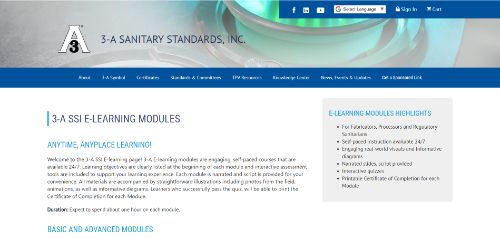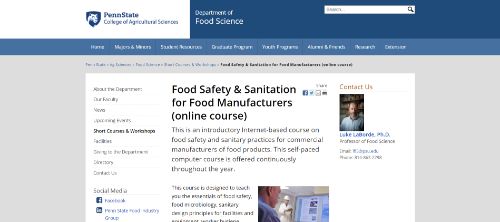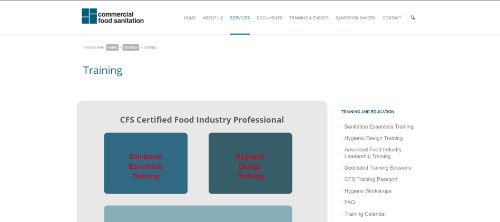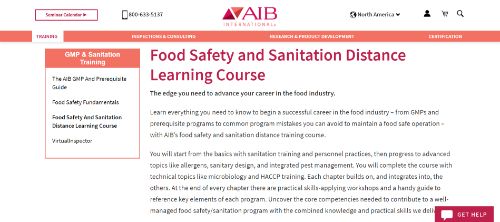Sanitation used to be a not-so-important subject, but that’s already in the past. Today, no matter how large or small an organization is, sanitary and hygienic practices should be regarded as a priority.
Consider this: deadly microbial contamination or other serious mishaps can happen in seconds and cause negative publicity, loss of customers, and financial losses to a company, yet it would take years to recover.
That makes food safety training important. Many food safety and sanitation training programs cover diverse topics to deliver the expertise required to ensure that food processing is entirely safe and hygienic, including equipment design, purchasing, receiving, and raw material storage, as well as operation and finished goods distribution. Roles and responsible persons also need to be clearly defined, as well as the reasons why these practices are put in place.
Sanitary and hygienic design is an important topic that shouldn’t be omitted in sanitation training programs. For instance, learning about the choice of materials that will make contact with food is critical. Due to its corrosion and moisture resistance, formability, and cleanability, stainless steel has become a preferred material in the food industry.
Another aspect is the equipment purchase. Purchasing pieces of equipment that have no certification marks from hygienic standards organizations has some drawbacks. Non-certified equipment not designed according to hygienic design standards and best practices could lead to an unnecessary increase in cleaning time that could have been better spent on actual food processing, not to mention the potential regulatory risks that come with using non-certified equipment.
That’s why food, beverage, and pharmaceutical companies give great importance to hygienic, cleaning-friendly designs. This is where equipment with a 3-A symbol or EHEDG certification have the advantage. Check out this blog post to learn more about the benefits of using equipment built with sanitary design principles.
General sanitation training courses are offered by universities and specialized institutions. Several companies and non-profit organizations do offer in-house and in-depth training programs as well. Below are a few such training courses that can help your organization get a start on sanitation and hygienic design training.

The 3-A SSI (3-A Sanitary Standards Inc.) is a non-profit organization that’s based in the U.S. It’s dedicated to improving hygienic design in the food, beverage, and pharmaceutical industries. Their standards and practices are designed to ensure product quality as well as protect public health.
It was not until 1944 that the U.S. Public Health Service fully cooperated with 3-A’s program. The 3-A standards are now crucial as food industry players need to comply with the Food Safety Modernization Act (FSMA). FSMA has specific requirements that need to be met in order to preserve sanitary conditions during food production, handling, and transport.
3-A Sanitary Standards and Accepted Practices cover most food processing equipment, like vessels, pumps, valves, sensors, and heat exchangers. That’s why original equipment manufacturers (OEMs) are the first to benefit from following the 3-A standards. Any piece of equipment that has been evaluated to conform with hygienic requirements can use and display the 3-A symbol. These standards and practices are internationally recognized, mainly for dairy and food processing equipment.
3-A SSI introduced a series of three new e-learning modules for interested students. Most of the contents are based on the “ANSI/3-A 00-00-2014, 3-A Sanitary Standards for General Requirements,” a collection of sanitary and hygienic design criteria in various 3-A Sanitary Standards and Accepted Practices. The modules also touch on criteria from EHEDG and other related organizations.
Since the modules are online, they can be taken at any time and at the student’s pace. While 3-A SSI’s modules aren’t intended to compete with university or corporate training courses, they contain sufficient insights that early sanitation practitioners will find valuable. This training program is also free.
Check out the sanitation training program here.

Pennsylvania State University offers several food safety and sanitation training programs. One of them is an online introductory course, which covers food safety, microbiology, sanitary design training principles for facilities and equipment, hygiene practices for employees, cleaning and sanitizing procedures, plant security, and more.
Like 3-A SSI’s modules, Penn State’s course is self-paced and available throughout the year. That means anyone can take the course independently and at their own pace. Once the course is completed, Penn State University awards a certificate that demonstrates the student’s commitment to food safety and sanitary processes.

Commercial Food Sanitation (CFS) is an Intralox company since 2012. The company specializes in sanitary design and GMP (Good Manufacturing Practices) and is highly regarded for its sanitation consultants and hygienic design experts. CFS also provides hands-on training on various topics, including sanitation essentials and hygienic design.

EHEDG (European Hygienic Engineering and Design Group) has been supporting sanitary and hygienic design efforts in food production and packaging since 1989. With its network of research institutes, it provides scientific grounds on which standards could be built or improved upon. The EHEDG certificate is recognized primarily in Europe.
For OEMs’ benefit, EHEDG has worked with 3-A to harmonize their standards. While there are some differences between the 3-A standards and EHEDG guidelines, both organizations share the same goal: to contribute to the advancement of hygienic design and engineering.
EHEDG also provides basic and advanced training in hygienic design and engineering. Check out EHEDG’s training courses here.

Lastly, AIB International, formerly known as the American Institute of Baking, started in 1919 and consists of experts in baking production, cereal science, food safety, and hygiene.
AIB International offers a “Food Safety and Sanitation Distance Learning Course,” which covers sanitary design and 21 other food safety training topics. Check this AIB sanitation training program outline here.
While there are a number of sanitary and hygienic design training programs, these five options offer a good starting point for learning the basic principles of hygienic design as well as practical applications and how sanitary design impacts the industry.
Our sales engineers are experts in automatic asset tracking, tagging and identification,a nd can answer all your questions. Get in touch now.
Lets Talk ›